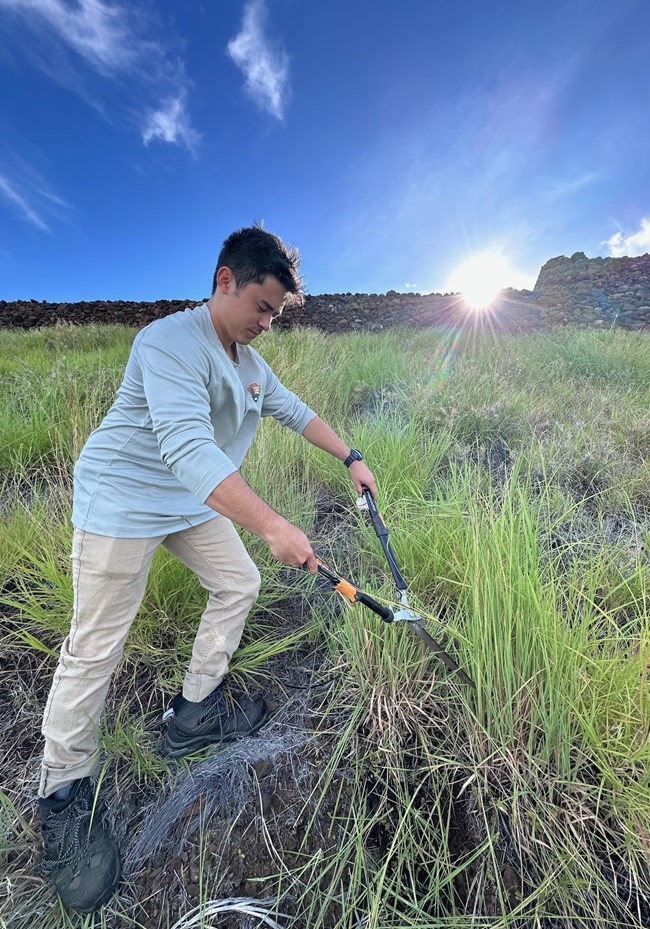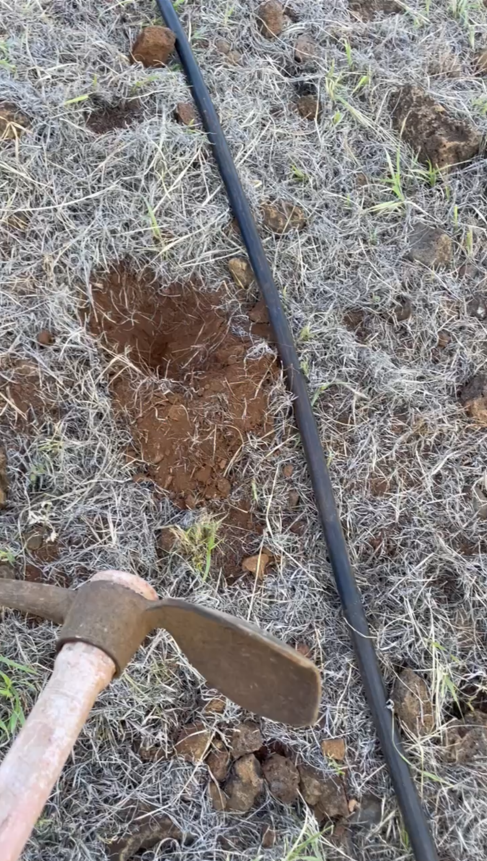Last updated: April 16, 2025
Article
Dylan Velez: Maintenance Action Team Member on Pili Grass Revival Project

NPS
What inspired you to pursue an internship at Puʻukoholā Heiau? Was there a specific moment or event that sparked your interest?
I attended a Hawaiian culture-focused charter school from early elementary up until my senior year of high school, and we would visit Puʻukoholā Heiau National Historic Site several times each school year to assist in their preparations for ceremonies and cultural events. These early experiences gave me an appreciation for the cultural and historical significance of Puʻukoholā. In my last year of college, I was accepted into an internship program through my university called the Pacific Internship Program for Exploring Science (PIPES), which partnered with the NPS as well as other organizations and agencies across Hawai‘i Island. As interns, we were given a choice of projects to work on at different host organizations, and one of the potential projects was helping to restore native pili grass (Heteropogon contortus) at Puʻukoholā. The pili grass restoration project immediately appealed to me aligning perfectly with my interests in ecosystem restoration and indigenous land management.

NPS
What is your background, and how have your skills or experiences helped you in your internship?
As an undergraduate, I studied Environmental Science. I have also participated in several internships in conservation and natural resource management prior to my internship at PUHE. I would say that both my educational background and prior field experiences have helped me in this internship. My undergraduate education equipped me with skills like plant identification, which is helpful especially when removing invasive species. I also had some experience with outplanting native plants, which came in handy when it came time for us to outplant our pili grass plugs. I definitely learned lots of new skills while interning at PUHE, but it was helpful to have a good foundation through my background.
What do you find most rewarding about your internship work?
Knowing that our pili outplanting work will contribute in the long-term to the cultural and ecological revitalization of Pu‘ukoholā is very rewarding to me. I also take pride in knowing that I played a small part in increasing the area’s fire resilience, which will help the park to better withstand and respond to future brush fires since pili is a fire-adapted species.
What were your primary hands-on responsibilities in the Pili Grasslands restoration project?
My most important task as an intern was assisting my fellow intern Kilinoe and the other PUHE staff in outplanting pili plugs to a new site adjacent to the heiau. We prepared the new site by clearing the invasive grasses and establishing rows, which we then lined with drip-irrigation lines. We dug shallow holes along the rows and then harvested several mature clumps of pili grass from the park’s in-situ nursery, which we separated into small plugs for outplanting. The resource management staff at PUHE taught us the outplanting techniques that they had used on previous projects, such as using small rocks to “mulch” around the base of the pili plugs. After planting, Kilinoe and I were responsible for turning on the water daily for 30 minutes to irrigate the pili.

NPS
You also mentioned conducting research on the cultural significance of pili. What insights did you gain from this?
I dove into the traditional uses of pili by kanaka ‘ōiwi (Native Hawaiians), particularly its relationship with fire. One of my major breakthroughs was when I found a source from a Scottish botanist named Archibald Menzies, who visited Hawaii in the late 1700s. In his journals, he described a controlled burn of pili grasslands that was done by kanaka on the island of Kaua‘i. They explained to him that this was done in order to ensure that the next crop of grass would grow more vigorously, giving them plenty of pili to use for thatching material and medicinal purposes. This showed that Hawaiians deeply understood the fire-adapted properties of pili, which was an amazing insight!
Can you share a specific experience or accomplishment during your work that you're particularly proud of?
I‘m particularly proud of how our outplanting project turned out. We outplanted 321 new pili plugs and had an outplant survival rate of 84.7%! This was honestly higher than we had expected given Kawaihae’s extremely dry and harsh climate. I’m proud to have been a part of a successful restoration project that will have long-lasting impacts on the area.

NPS
What have you learned from your experience, both personally and professionally?
Professionally, one of the most impactful lessons I learned was the importance of partnerships between the NPS and local organizations, especially when it comes to conservation and natural resource management. While our pili project took place within a small area of the park, it is a part of a larger restoration effort in the South Kohala district that will involve other local conservation groups and agencies. On a personal level, I was able to deepen my understanding of the intersection between natural and cultural resources. Pili performs important ecological functions like fire mitigation and soil moisture retention, but it also represents a vital resource for Hawaiian cultural practitioners (for example, kauhale builders who use the grass as a thatching material for traditional houses). This is the case with many of our natural resources here in Hawai‘i. Additionally, I learned how to better integrate scientific principles with indigenous knowledge in order to manage resources responsibly and sustainably.

NPS
What advice would you give to someone considering an internship at a national park?
Echoing what other NPS interns have said, I would highly recommend participating in local programs that already have partnerships with the National Park Service. I was fortunate enough to be a part of one of these (the PIPES program) this past summer and it definitely paid off. I’d also encourage anyone interested in interning at a national park to talk to and learn from as many people who are already involved with the park service as possible. During my internship, I got to talk with several current NPS employees, both at PUHE and elsewhere, and it gave me a better understanding of career paths within the park service. Lastly, I’d encourage them to approach the internship with an open mind. Participate in any activity at the park that you can, whether it’s going on a hike with park staff or even sitting in on a meeting! I found that just putting myself into these environments taught me a lot about how resource management and other day-to-day operations work at national parks.
